

Resources for Primary and Secondary Students - ABC Education. Home. Yale Professor Jason Stanley Identifies 3 Essential Features of Fascism: Invoking a Mythic Past, Sowing Division & Attacking Truth. New books on fascism are popping up everywhere, from independent presses, former world leaders like Madeleine Albright, and academics like Jason Stanley, Jacob Urowsky Professor of Philosophy at Yale University.

Stanley’s latest book, How Fascism Works: The Politics of Us and Them, has been described as a “vital read for a nation under Trump. " And yet, as The Guardian’s Tom McCarthy writes, one of the ironies Stanley points out is that—despite the widespread currency of the term these days—fascism succeeds by making “talk of fascism… seem outlandish.” Is it? The word has certainly been diluted by years of misuse. Umberto Eco wrote in his 1995 essay “Ur-Fascism” that "fascist" as an epithet was casually thrown around “by American radicals… to refer to a cop who did not approve of their smoking habits.” “The fascist game can be played in many forms,” Eco wrote, depending on the national mythologies and cultural history of the country in which it takes root. 1. 2. 3.
Related Content: Umberto Eco Makes a List of the 14 Common Features of Fascism. Creative Commons image by Rob Bogaerts, via the National Archives in Holland One of the key questions facing both journalists and loyal oppositions these days is how do we stay honest as euphemisms and trivializations take over the discourse?

Can we use words like “fascism,” for example, with fidelity to the meaning of that word in world history? The term, after all, devolved decades after World War II into the trite expression fascist pig, writes Umberto Eco in his 1995 essay "Ur-Fascism," “used by American radicals thirty years later to refer to a cop who did not approve of their smoking habits. " In the forties, on the other hand, the fight against fascism was a "moral duty for every good American. " (And every good Englishman and French partisan, he might have added.) Eco grew up under Mussolini’s fascist regime, which “was certainly a dictatorship, but it was not totally totalitarian, not because of its mildness but rather because of the philosophical weakness of its ideology. Fifty lessons from the Treaty of Versailles, 100 years after the ‘war to end all wars’ failed to end all wars. The Treaty of Peace Between the Allied and Associated Powers and Germany was the most important of the many treaties that brought the First World War to a close a century ago.
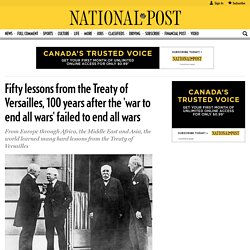
It was signed at the palace of Versailles, King Louis XIV’s lavish palace outside Paris, in the summer of 1919, several months after Germany agreed to an armistice and surrendered. (37) Before and After: Easter in Peacetime and Wartime (1941) How Did the Nazis Do What They Did in Such a Civilised and Culturally Advanced Country? This article is an edited transcript of The Myth and Reality of Hitler’s Secret Police with Frank McDonough on Dan Snow’s History Hit, first broadcast 23 January 2016.
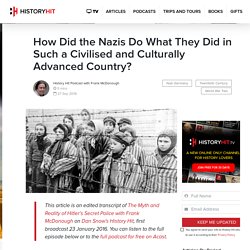
You can listen to the full episode below or to the full podcast for free on Acast. We all have an idea of what a civilized society looks like. We like classical music, we go to the theatre, we play the piano, we like to read nice novels, we like to hear poetry and we take our children for walks in the countryside. We think all those things make us civilized. But look at Reinhard Heydrich: he had a piano in his office and would play Mozart at lunchtime. It’s important to understand that civilisation is more than just culture. People like Heydrich lost their morality. A whole new world: how WWI brought new skills and professions back to Australia. The first world war was significant to the formation of Australian national identity and defining national characteristics, such as making do and mateship.
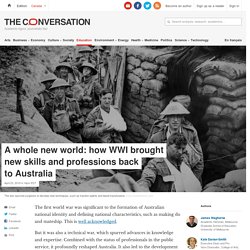
This is well acknowledged. But it was also a technical war, which spurred advances in knowledge and expertise. Hitler’s Purge: The Night of the Long Knives Explained. While the SA were dreaming about using their long knives against their hated enemies; the middle classes and the Reichswehr; it was the SS who actually used them in June 1934 to crush Ernst Röhm and his mutinous SA rabble once and for all. Röhm’s SA was out of control The SA under the command of Ernst Röhm were a turbulent, uncontrollable and mutinous rabble who were braying for blood with a ‘second revolution’ against conservatives and the existing German Defence Force (Reichswehr) which Hitler wanted to build into the new German Army (Wehrmacht).
Hitler tried to pacify Röhm by making him a Minister without portfolio in December 1933, but Röhm was not satisfied and wanted to destroy the existing Reichswehr and take over with his band of three million underpaid SA. From Hyperinflation to Full Employment: Nazi Germany’s Economic Miracle Explained. Before the Nazis took control of the Reichstag in 1933, around 6 million Germans were unemployed; the German economy was in total collapse, Germany had no international credit rating, and was almost bankrupt from World War 1 reparations payments.
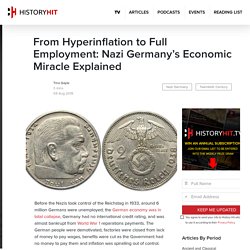
The German people were demotivated, factories were closed from lack of money to pay wages, benefits were cut as the Government had no money to pay them and inflation was spiralling out of control. Hyperinflation: A five-million mark note. Third Reich economic nationalism Inside an incredible three years, all this was changed. How Did the Nazis Do What They Did in Such a Civilised and Culturally Advanced Country?
Hitler’s Purge: The Night of the Long Knives Explained. Rare 1940 Audio: Thomas Mann Explains the Nazis’ Ulterior Motive for Spreading Anti-Semitism. Here's a rare recording of the German writer Thomas Mann, author of Buddenbrooks and The Magic Mountain, explaining what he sees as the real reason behind the systematic spreading of anti-Semitism in Nazi Germany.

It's from an NBC radio address Mann gave on March 9, 1940, while he was living in California. Mann had gone into exile from Germany in 1933, shortly after Adolf Hitler was elected chancellor and began seizing dictatorial powers. Mann had been an outspoken critic of the Nazi party since its emergence in the early twenties. In 1930, a year after he received the Nobel Prize in Literature, Mann gave a high-profile "Address to the Germans: An Appeal to Reason," in which he denounced the Nazis as barbarians. A Christian man married to a Jewish woman, Mann often spoke against the Nazi's anti-Semitism, which he saw as part of a larger assault on the Mediterranean underpinnings of Western Civilization. Related Content: Rediscovered: The First American Anti-Nazi Film, Banned by U.S. Chilling black and white footage of 'Hitler's girls' specially selected for 'holiday camp' to indoctrinate them.
Chilling black and white footage shows 'Hitler's girls' - specially selected for their Aryan appearance - to go to a 'holiday camp' to be indoctrinated.
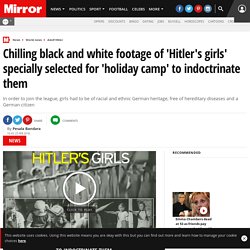
At first glance the clip could be a group of girls from any typical summer camp. But paying closer attention it is clear to see that the happy teens are part of Hitler’s League of German Girls and they are raising a Swastika flag. While the Nazi Party was setting up the horrific concentration camps in Germany in the 1930s - they were also running country service camps. At the camps where girls were specially selected based on their appearance, they were indoctrinated by Hitler’s ideology and virulent anti-Semitism.
Recently unearthed footage reveals the activities inside a 1939 Nazi Country Service camp or Landjahr for girls aged between 14-18. The Educated Teacher. Last year my co-teacher and I were a little crunched for time when teaching the interwar years in Europe.

We wanted to get across the economic and social problems that Europeans faced and how it influenced the choices they made, so I designed these learning stations to allow students to use primary and secondary sources to discover these facts for themselves. Tempest in a teapot (friendlyatheist: savagemike: angrylittledad: ...)